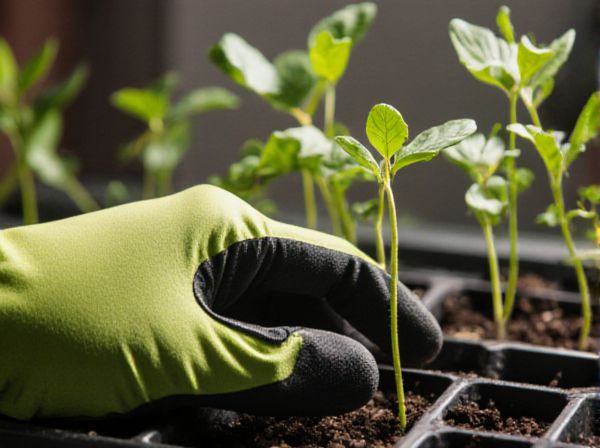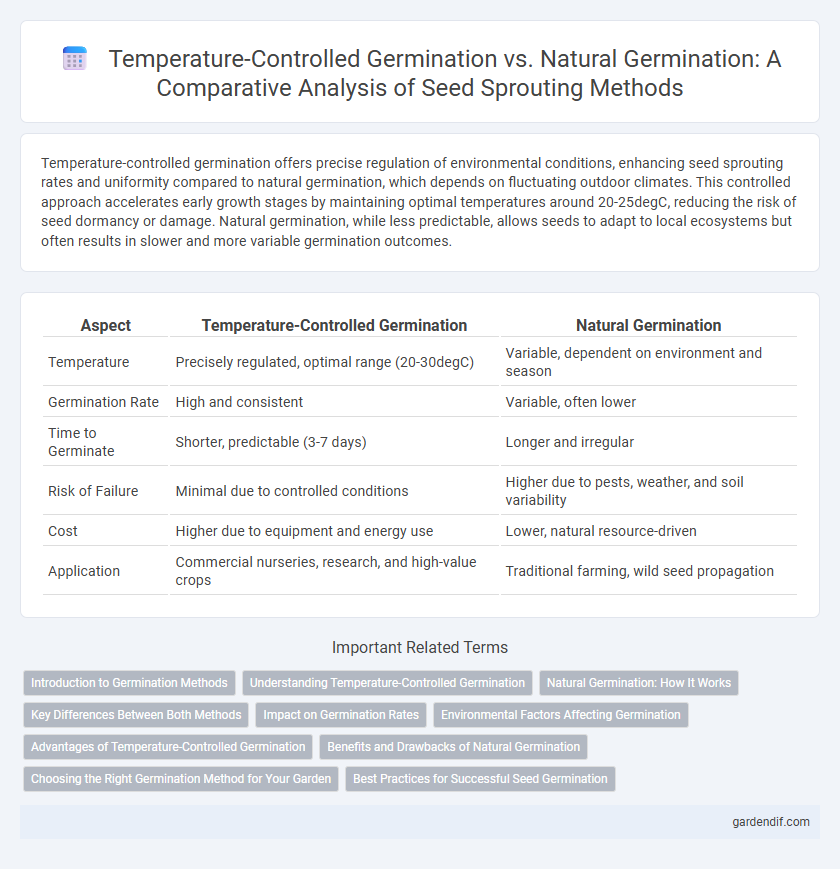
Temperature-controlled germination vs Natural germination Illustration
Temperature-controlled germination offers precise regulation of environmental conditions, enhancing seed sprouting rates and uniformity compared to natural germination, which depends on fluctuating outdoor climates. This controlled approach accelerates early growth stages by maintaining optimal temperatures around 20-25degC, reducing the risk of seed dormancy or damage. Natural germination, while less predictable, allows seeds to adapt to local ecosystems but often results in slower and more variable germination outcomes.
Table of Comparison
| Aspect | Temperature-Controlled Germination | Natural Germination |
|---|---|---|
| Temperature | Precisely regulated, optimal range (20-30degC) | Variable, dependent on environment and season |
| Germination Rate | High and consistent | Variable, often lower |
| Time to Germinate | Shorter, predictable (3-7 days) | Longer and irregular |
| Risk of Failure | Minimal due to controlled conditions | Higher due to pests, weather, and soil variability |
| Cost | Higher due to equipment and energy use | Lower, natural resource-driven |
| Application | Commercial nurseries, research, and high-value crops | Traditional farming, wild seed propagation |
Introduction to Germination Methods
Temperature-controlled germination uses precise thermal regulation to optimize seed sprouting rates and uniformity, enhancing early plant development compared to natural germination methods reliant on fluctuating environmental conditions. This method enables consistent seedling emergence by maintaining ideal temperature ranges tailored to specific species, reducing germination time and improving overall success rates. Natural germination depends on ambient temperature variations, often resulting in variable germination timing and lower predictability in crop establishment.
Understanding Temperature-Controlled Germination
Temperature-controlled germination utilizes precise thermal regulation to optimize seed sprouting conditions, enhancing germination rates and uniformity compared to natural germination processes influenced by fluctuating ambient temperatures. This method maintains consistent warmth, typically between 20degC and 30degC, which accelerates enzymatic activity and metabolic processes essential for seed development. Controlled environments also reduce risks of seed dormancy and pathogen exposure, leading to improved seedling vigor and predictability in agricultural crop establishment.
Natural Germination: How It Works
Natural germination occurs when seeds undergo environmental conditions such as temperature fluctuations, moisture, and light exposure essential for breaking dormancy and initiating growth. Soil temperature plays a critical role, with most seeds requiring an optimal temperature range--often between 15degC and 30degC--to activate enzymes that trigger metabolic processes during natural germination. This method relies on seasonal cues and environmental interactions, making it a robust but variable process compared to temperature-controlled germination systems.
Key Differences Between Both Methods
Temperature-controlled germination maintains optimal warmth using controlled environments to accelerate seed sprouting and improve uniformity, while natural germination relies on ambient conditions with variable temperature fluctuations affecting growth rates. Controlled germination allows precise regulation of factors like humidity and light, enhancing seed viability and reducing germination time compared to unpredictable natural settings. Seedlings from temperature-controlled environments often exhibit higher vigor and consistent development, contributing to improved agricultural productivity.
Impact on Germination Rates
Temperature-controlled germination significantly enhances germination rates by maintaining optimal thermal conditions, which accelerate seed metabolic processes and improve uniformity in seedling emergence. In contrast, natural germination rates are subject to environmental temperature fluctuations, often resulting in slower and less predictable seed sprouting. Studies indicate that controlled temperature regimes can increase germination success by up to 30% compared to seeds exposed to ambient natural conditions.
Environmental Factors Affecting Germination
Temperature-controlled germination ensures optimal and consistent heat levels, directly influencing enzyme activity and seed metabolism for faster and more uniform sprouting. Natural germination depends on fluctuating environmental conditions such as ambient temperature, soil moisture, and light exposure, which can lead to variable germination rates. Key environmental factors affecting germination include temperature range between 15degC to 30degC, adequate oxygen availability, and appropriate soil pH, all critical for successful seed development.
Advantages of Temperature-Controlled Germination
Temperature-controlled germination offers precise regulation of environmental conditions, ensuring optimal seed sprouting rates and uniform growth compared to natural germination. This method reduces the risk of seedling stress caused by fluctuating outdoor temperatures and enhances germination speed, leading to more predictable crop establishment. Controlled temperature settings also enable year-round seed propagation, improving agricultural productivity and resource efficiency.
Benefits and Drawbacks of Natural Germination
Natural germination offers the benefit of cost-effectiveness by eliminating the need for artificial temperature regulation, allowing seeds to germinate in their native environmental conditions which can enhance genetic adaptation over time. However, its drawbacks include vulnerability to fluctuating temperatures, unpredictable moisture levels, and potential exposure to pests and diseases, leading to inconsistent germination rates and delays in seedling development. These factors make natural germination less reliable for large-scale agricultural production compared to temperature-controlled methods.
Choosing the Right Germination Method for Your Garden
Temperature-controlled germination offers precise regulation of warmth, enhancing seed sprouting rates and enabling year-round cultivation regardless of external weather conditions. Natural germination relies on ambient environmental factors, promoting resilience and adaptability in plants but often resulting in variable germination times. Selecting the appropriate germination technique depends on your garden's climate, desired planting schedule, and the specific seed species' temperature sensitivity to optimize growth success.
Best Practices for Successful Seed Germination
Temperature-controlled germination ensures consistent warmth between 20-25degC, optimizing enzyme activity and uniform seed sprouting compared to fluctuating outdoor temperatures that can delay or reduce germination rates. Utilizing temperature-controlled environments such as germination chambers or heated mats helps maintain ideal moisture and prevents seed rot, enhancing overall success. Monitoring temperature alongside seed type-specific requirements supports faster, more predictable seedling development than relying solely on natural conditions.
Temperature-controlled germination vs Natural germination Infographic

 gardendif.com
gardendif.com